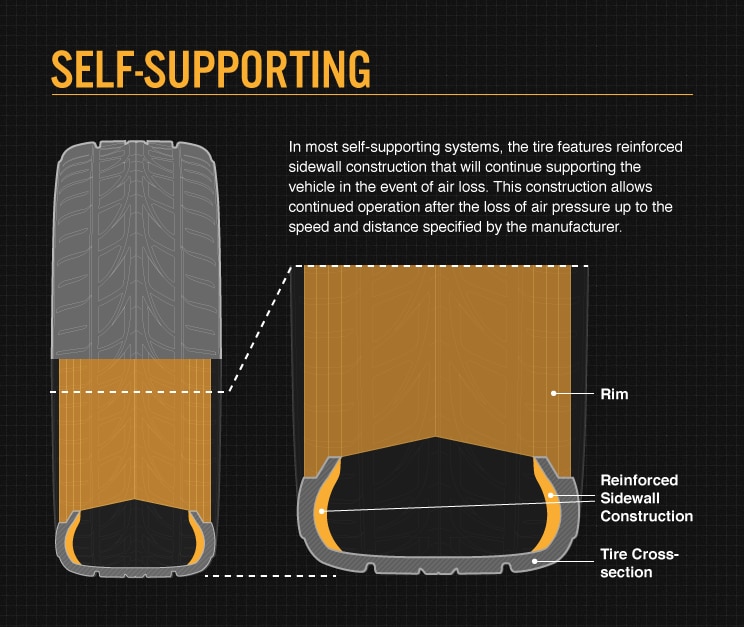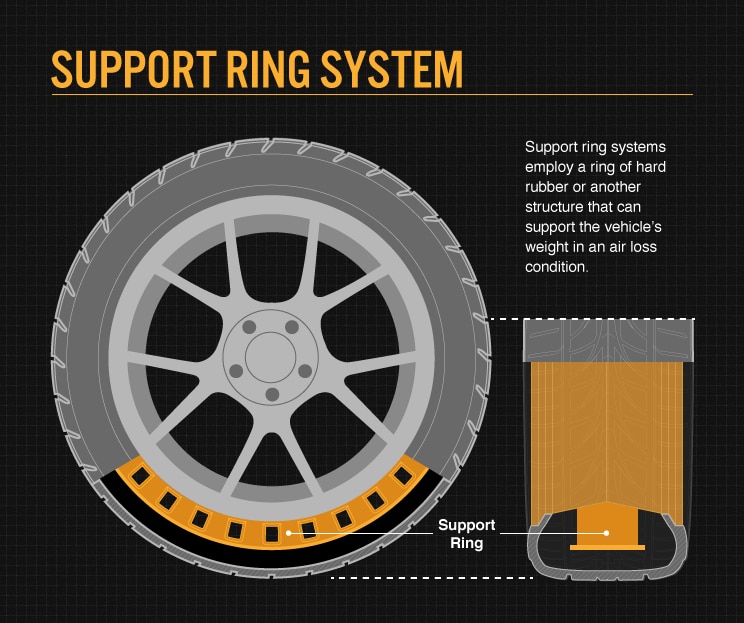Run-flat tires are specially designed tires that allow you to drive temporarily after a puncture. They offer improved safety and convenience.
Run-flat tires are gaining popularity for their unique capability to keep vehicles moving even after a puncture. They are constructed with reinforced sidewalls, enabling drivers to continue driving at reduced speeds for a short distance, usually up to 50 miles.
This feature eliminates the immediate need to change a tire on the roadside, enhancing driver safety and convenience. Perfect for those who prioritize safety and peace of mind, run-flat tires are especially beneficial in areas where stopping for a tire change might be hazardous. These tires often come as standard equipment on many new vehicles, reflecting their growing acceptance and reliability.

The Advent Of Run-flat Tires
Run-flat tires have revolutionized the automotive world. They offer a safer driving experience. These tires allow vehicles to continue moving even after a puncture. Let’s dive into the history and evolution of these incredible tires.
Early Innovations In Tire Technology
Early tire designs focused on basic functionality. The first tires were simple rubber bands. They evolved into more complex structures over time. Early tires were prone to frequent punctures. This led to the need for better solutions.
In the early 20th century, tire manufacturers introduced inner tubes. These tubes provided a cushion of air. They improved ride comfort and safety. Yet, punctures still remained a significant issue.
The Introduction Of Run-flat Designs
The 1980s marked a significant milestone. This era saw the birth of run-flat technology. Bridgestone and Michelin were early pioneers. They designed tires that could run flat for limited distances.
Run-flat tires feature reinforced sidewalls. These sidewalls support the vehicle’s weight even when deflated. This allows the car to travel up to 50 miles at reduced speeds.
| Brand | Year Introduced | Distance Travelable (miles) |
|---|---|---|
| Bridgestone | 1986 | 50 |
| Michelin | 1987 | 50 |
Modern run-flat tires come in two main types:
- Self-Supporting
- Auxiliary-Supported
Both types aim to improve safety and convenience. Run-flat tires eliminate the need for a spare tire. They provide peace of mind for drivers.

How Run-flat Tires Work
Run-flat tires are a game-changer in the automotive world. They allow you to drive even after a puncture. But how do they work? Let’s dive into the mechanics of these remarkable tires.
The Science Behind The Durability
Run-flat tires are built with stronger sidewalls. These sidewalls support the vehicle even with no air pressure. This technology helps maintain the tire’s shape. The reinforced sidewalls reduce the risk of a blowout.
Self-supporting run-flat tires have special rubber inserts. These inserts provide extra strength. They also help in maintaining control of the vehicle.
Auxiliary-supported run-flat tires use a support ring inside the tire. This ring helps the tire maintain its form. It allows the driver to safely reach a service station.
Comparison With Traditional Tires
Traditional tires rely heavily on air pressure. They lack the strong sidewalls of run-flat tires. A puncture in a traditional tire can lead to a flat tire quickly.
Run-flat tires let you drive up to 50 miles after a puncture. Traditional tires need immediate attention. Run-flat tires provide a safety margin.
| Feature | Run-Flat Tires | Traditional Tires |
|---|---|---|
| Sidewall Strength | Strong | Standard |
| Driveable After Puncture | Up to 50 miles | Immediate Replacement Needed |
| Maintenance | Less Frequent | More Frequent |
- Run-flat tires offer safety and convenience.
- They reduce the need for a spare tire.
- Run-flat tires provide peace of mind.
Advantages Of Run-flat Tires
Run-flat tires offer numerous benefits for drivers. They provide increased safety features and convenience on the road. Discover why these tires might be a great choice for your vehicle.
Improved Safety Features
Run-flat tires are designed to keep you safe. They allow you to drive even after a puncture. This feature reduces the risk of accidents. You won’t need to stop immediately. This is especially useful in dangerous areas.
These tires maintain stability even when deflated. This helps you control the vehicle. You can drive for a limited distance to reach a safe place. Typically, you can drive up to 50 miles at 50 mph with a flat tire.
Run-flat tires also eliminate the need for a spare tire. This means less weight in your car. It improves fuel efficiency and reduces vehicle wear and tear.
Convenience On The Road
Run-flat tires offer significant convenience. You can continue driving even with a flat. This saves you time and hassle. You won’t need to change the tire on the spot.
These tires are especially handy in bad weather. Changing a tire in the rain or snow is dangerous. With run-flat tires, you can drive to a safe location.
They also reduce the need for roadside assistance. This can save you money. You won’t need to call for help if you have a flat.
| Advantages | Details |
|---|---|
| Improved Safety | Drive up to 50 miles after a puncture |
| Convenience | No need to change the tire immediately |
| Weight Reduction | No spare tire needed |
| Cost Savings | Less need for roadside assistance |

Considering The Drawbacks
While run-flat tires offer undeniable advantages, they also come with certain drawbacks. It’s important to consider these before making a decision.
Potential Ride Comfort Trade-offs
Run-flat tires often have stiffer sidewalls. This can affect ride comfort. The stiffer design means less cushioning. Many drivers report a harsher ride compared to regular tires. This trade-off is necessary for the tire to support the vehicle when flat.
Additionally, the increased stiffness might result in more road noise. This noise can be distracting and might reduce driving pleasure. If comfort is a priority, this is a significant factor to consider.
Cost Implications And Replacement
Run-flat tires generally cost more than regular tires. This higher cost can be a deterrent for some. Let’s look at a comparison:
| Type of Tire | Average Cost Per Tire |
|---|---|
| Regular Tires | $80 – $150 |
| Run-Flat Tires | $150 – $300 |
Replacement of run-flat tires can also be more expensive. Many vehicles require special equipment to fit these tires. This can increase labor costs during replacement.
Another point to note is availability. Run-flat tires might not be as widely available. This can lead to delays when you need a quick replacement.
The Future Of Run-flat Tires
Run-flat tires are becoming more popular. They allow you to keep driving after a puncture. The future of these tires is exciting. New technologies and trends are shaping their development.
Technological Advancements On The Horizon
Run-flat tire technology is always improving. Smart tire sensors can now alert you to tire issues instantly. This helps you stay safe on the road.
New materials are also being used. These materials make tires lighter and stronger. Reinforced sidewalls are more durable than ever. They can handle more wear and tear.
Self-sealing tires are another exciting advancement. These tires can seal small punctures on their own. You won’t even notice most small punctures.
Adoption Trends In The Automotive Industry
The automotive industry is adopting run-flat tires rapidly. Many new cars now come with run-flat tires as standard. Luxury car brands are leading the way. They offer run-flat tires for better safety and convenience.
Electric vehicles (EVs) are also using run-flat tires more. These tires help reduce the weight of EVs by eliminating the need for a spare tire. This extends the driving range of EVs.
Fleet operators are also interested in run-flat tires. They reduce downtime and maintenance costs. This is especially important for delivery and ride-sharing services.
Here is a quick comparison of traditional tires and run-flat tires:
| Feature | Traditional Tires | Run-Flat Tires |
|---|---|---|
| Driving After Puncture | Not Possible | Possible |
| Need for Spare Tire | Yes | No |
| Weight | Lighter | Heavier |
| Cost | Lower | Higher |
Frequently Asked Questions
What Is The Disadvantage Of A Run-flat Tire?
Run-flat tires often have a stiffer ride, reduced tread life, and higher cost. They can also be harder to repair.
Which Is Better, Run Flat Or Regular Tires?
Run-flat tires offer convenience and safety during a puncture. Regular tires provide better ride comfort and are generally cheaper. Choose based on your driving needs.
Can You Put Air In Run-flat Tires?
Yes, you can put air in run-flat tires. Ensure the pressure matches the manufacturer’s recommendation for optimal performance.
What Is So Special About Run-flat Tires?
Run-flat tires allow you to drive even after a puncture. They provide safety and convenience by eliminating the need for immediate tire changes.
What Are Run-flat Tires?
Run-flat tires can be driven after a puncture. They allow you to reach a service station without changing the tire.
Conclusion
Run-flat tires offer safety and convenience by allowing you to drive even after a puncture. They eliminate the need for immediate tire changes. By understanding their benefits, you can make an informed decision. Consider your driving habits and preferences to determine if run-flat tires are the right choice for you.





















